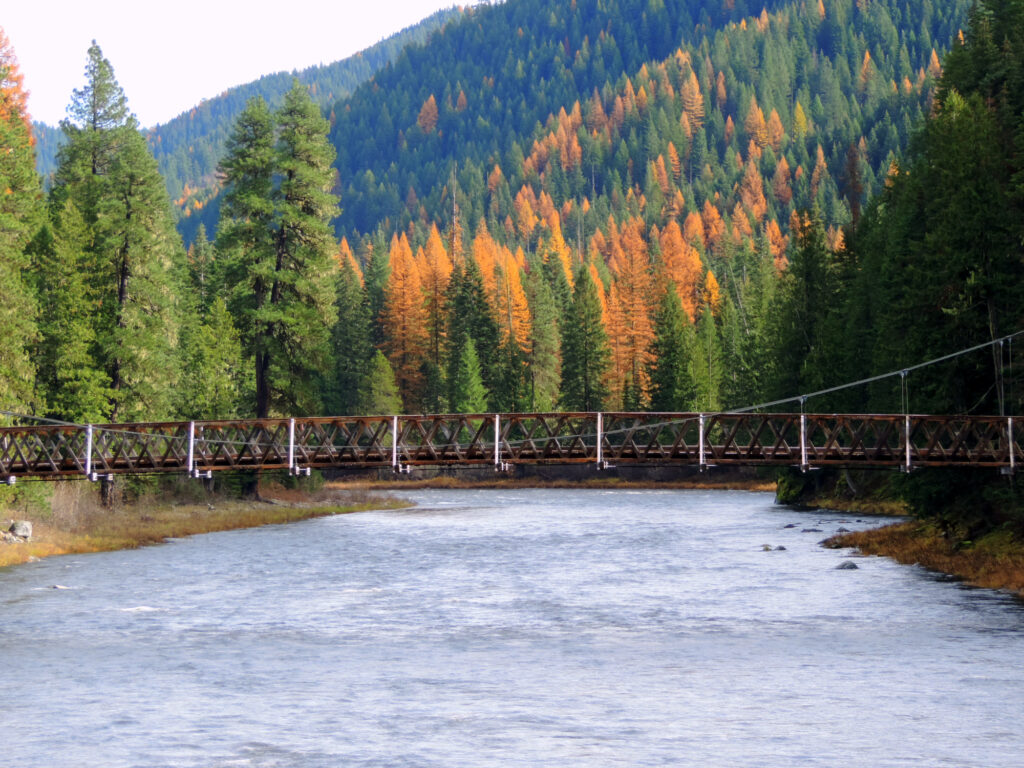
Foot bridge over Lochsa River with Tamaracks in the background. (File/Getty Images)
Deep in Idaho’s Clearwater Mountains, along the beautiful Lochsa River, is a stand of ancient cedar trees. These trees stand hundreds of feet tall and are hundreds of years old. They have seen a lot of American and Idaho history.
They were standing long before Europeans arrived in these mountains, back when the Nez Perce traveled through the Clearwater Mountains along what they called the Road to the Buffalo, the route they used to travel from their Idaho home to the buffalo hunting grounds in Montana.
They were standing when explorers Lewis and Clark passed by less than mile away on their 1805-06 historic trek across North America to the Pacific Ocean.
These trees were standing in 1877 when Chief Joseph and the Nez Perce were fleeing the U.S. Cavalry in their heartbreaking effort to reach the safety of Canada.
Conservation historian Bernard DeVoto camped under these trees in the late 1940s while working on his editing of the Lewis and Clark journals. After DeVoto’s death, this grove of cedar trees was named the DeVoto Memorial Cedar Grove, and his ashes were spread on this site.
It’s no accident that these old cedar trees are still standing. They remain standing because they are on public lands. Public lands, in which every American has a stake. Surrounding forests, not on public lands, tell a far different story.
A few miles to east of the DeVoto Cedar Grove are lands that once belonged to a railroad company.
In the 1860s, railroad companies were given vast tracks of lands in the West to facilitate settlement efforts and ease the way for possible cross country railroad routes. Only a few such routes panned out, so the railroads eventually sold much of their timber lands to private timber companies. These companies, out to maximize profits for shareholders, ravaged these forests, brutally logging these landscapes and leaving behind eroded hillsides, polluted streams, and miles and miles of stumps.
Even today these denuded lands continue to dump sediment into the headwaters of the Lochsa River.
A few miles to the west of the DeVoto Cedar Grove are forest lands that ended up owned by another entity, this time the state of Idaho. Forests owned by the state are mandated to be managed to produce the maximum revenue for the school system.
This means logging. Lots of logging. The state lands west of the DeVoto Cedar Grove are a jumbled maze of logging roads and clearcuts. Any old trees once there are long gone.
Besides his work on the Lewis and Clark journals, Bernard DeVoto is best known for his conservation advocacy in Harpers Magazine in the 1940s. It was here that DeVoto blew the whistle on the efforts by the national livestock associations to turn all of America’s public lands over to individual states and eventually private ownership. DeVoto’s writing galvanized opposition that helped defeat that effort at that time.
12 states get behind Utah’s lawsuit to take over millions of acres of federally controlled land
But bad ideas die hard.
There’s always remained smoldering efforts by private entities and the politicians in their pocket to somehow get their hands on public lands.
The effort is back again. Idaho Attorney General Raúl Labrador filed a friend of the court brief supporting Utah’s effort to dispose of public land to state ownership. While purportedly focused on lands managed by the Bureau of Land Management, which provide unmatched wildlife habitat and recreation opportunities to all Americans, Utah’s lawsuit raises the question of whether the federal government can hold lands in perpetuity at all.
If this effort were to succeed, you can bet the national forests would be next on the politician’s wish list.
Idaho sold off about one third of the land it received from the federal government upon statehood. Had Idaho gotten more land, it would have simply sold more of it.
It has generally been a short step from state ownership to private ownership. And private ownership has meant, for stands of old forests like the DeVoto Grove on the Lochsa, a quick trip to the nearest sawmill and money in the owner’s pocket.
Millions of acres of old growth forest, and the wildlife, clean water, and recreation opportunities supported by these forests, are gone forever by this route.
We in the West know what state or private ownership means for forests: Stumps, and lots of them. Both entities manage forests to maximize dollars generated.
In contrast, public lands mean trees hundreds of years old, superb wildlife habitat, clear, clean water, and unmatched recreation opportunities. And our heritage.
You would be hard pressed to find many areas owned by states or private corporations where short-term monetary gains are sidelined for the sake of protecting a place of history like the DeVoto Cedar Grove.

